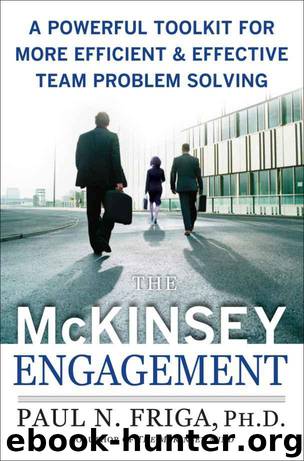The McKinsey Engagement : A Powerful Toolkit For More Efficient and Effective Team Problem Solving by Friga Ph.D Paul N

Author:Friga Ph.D, Paul N.
Language: eng
Format: mobi
Publisher: McGraw-Hill
Published: 2008-11-11T16:00:00+00:00
RULE 2: DEVELOP THE ISSUE TREE
Once the key question has been clearly articulated, the next step is to create an issue tree that will help organize the analysis of options. Since this is covered fairly thoroughly in The McKinsey Mind, I will touch on it only lightly here and focus my energy on discussing ways to implement the ideas on a project. There are essentially two types of issue trees: information trees and decision trees. The starting point is the information tree, which is used to quickly get a sense of the situation under investigation. The decision tree will be elaborated upon in the next Rule of Engagement, "Formulate Hypotheses." The information tree is basically a listing of the key pieces of the current situation. Another way to think of this is that the information tree should summarize, "What is going on?" whereas the decision tree asks, "What can we do?"
An important element of issue tree creation is the concept of MECE. MECE thinking is universally applied at McKinsey and many other top consulting firms. Essentially, MECE is a way of organizing any list in such a way that it has "no gaps and no overlaps." For example, if we were to lay out "buckets" for an investigation related to a profitability project, we would probably draw the issues as shown in Figure 5-2.
Download
This site does not store any files on its server. We only index and link to content provided by other sites. Please contact the content providers to delete copyright contents if any and email us, we'll remove relevant links or contents immediately.
Bad Blood by John Carreyrou(6271)
Rich Dad Poor Dad by Robert T. Kiyosaki(6174)
Principles: Life and Work by Ray Dalio(5955)
Playing to Win_ How Strategy Really Works by A.G. Lafley & Roger L. Martin(5489)
Management Strategies for the Cloud Revolution: How Cloud Computing Is Transforming Business and Why You Can't Afford to Be Left Behind by Charles Babcock(4438)
The Confidence Code by Katty Kay(4033)
Thinking in Bets by Annie Duke(3995)
American Kingpin by Nick Bilton(3504)
Delivering Happiness by Tony Hsieh(3280)
Project Animal Farm: An Accidental Journey into the Secret World of Farming and the Truth About Our Food by Sonia Faruqi(3013)
The Power of Habit by Charles Duhigg(2963)
Mastering Bitcoin: Programming the Open Blockchain by Andreas M. Antonopoulos(2890)
Brotopia by Emily Chang(2889)
The Tyranny of Metrics by Jerry Z. Muller(2845)
I Live in the Future & Here's How It Works by Nick Bilton(2842)
The Marketing Plan Handbook: Develop Big-Picture Marketing Plans for Pennies on the Dollar by Robert W. Bly(2792)
The Content Trap by Bharat Anand(2776)
Building a StoryBrand by Donald Miller(2751)
Applied Empathy by Michael Ventura(2742)
